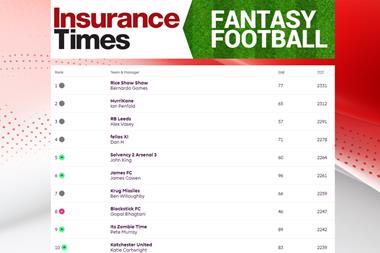In the second part of a quarterly series, Jim Keeling rounds up the deals in the insurance market and says, despite the credit crunch, there are still incentives to buy.
The past few years in the insurance sector have, in terms of businesses bought, sold and funded, been among the most active in 20 years.
This has been driven in part by consolidation within the UK broking and intermediary market. Historically it was the national brokers that bought up smaller rivals leading to the creation of world-wide global brands such as Marsh, Aon and Willis.
Now the focus is on the regional broker and intermediary market with a new wave of consolidation, started by Towergate 10 years ago and gathering pace since the onset of regulation by the FSA in 2005.
In 2006, broker consolidation reached new levels of activity with six of the Insurance Times Top 50 companies being acquired by either international insurance companies or major US broking groups. This pattern continued throughout 2007 with more big names disappearing from independent control and into the hands of insurers aggressively buying up distribution.
Other acquirers that are now well recognised – the likes of Oval, Giles and Jelf – joined the consolidation game and continued relentless expansion. The original leader in this field, Towergate, made 11 acquisitions in 2007 including Broker Network, itself a consolidator of smaller businesses.
The table (opposite), produced on a quarterly basis by Corpfin, suggests that activity across the insurance sector in the first two quarters of 2008 has kept apace with previous years for all but the largest deals. But this masks two trends that are revealed by closer examination of the underlying data.
First, the charts include all deals within each size bracket for which either the buyer or the seller is in the UK insurance sector. As a result, a number of acquisitions of property companies by insurers are included. And there has been a preponderance of these in the last quarter – perhaps indicating that the insurers believe the property market is already bottoming out and this is the time to fill their boots with bricks and mortar assets.
Second, around a third of the second quarter deals happened in the first five days of the quarter. Why? Because of huge fiscal incentives created by Chancellor Alastair Darling’s changes to the capital gains tax and non domicile tax regimes – which kept many owners and advisers up all night completing deals in the weeks and days preceding 6 April.
Focusing on deals with a value disclosed above £10m, that leaves just four non-property deals dated after 5 April. And, of those, two are still subject to conditions – Goshawk’s takeover by Enstar, being subject to shareholder approval, and Partnership Life’s acquisition by PAG, being subject to FSA approval.
So the going is slow and nowhere more than in the bigger deal category – where consideration paid is more than £100m. Here the full impact of the credit crunch is seen, exemplified maybe by the extraordinary and well publicised withdrawal of private equity backer Texas Pacific Group from the rescue of Bradford & Bingley.
Financial backers, led by providers of debt but now followed by equity funders are getting increasingly nervous. Though this has yet to spread fully to smaller deals, it has doubtless had a major impact on larger transactions where values are below even the worst levels seen in 2003.
But every cloud has a silver lining. Difficult times and even recession breed opportunities for those whose finances remain robust. And so we see on the horizon a bid, driven by the financial services sector’s woes, of around £7bn for the insurance arm of Royal Bank of Scotland. That alone – assuming of course it comes to fruition – will materially increase the M&A activity record for 2008.
What of the longer term outlook for the next six to 12 months? Back to the broking sector which has driven so much recent activity. There are, according to sector specialist Hansen Young, around 3,800 FSA-authorised general insurance intermediaries (and this is excluding those on the fringe such as motor dealers, vets and accountants who sell insurance as a sideline). So there remains a big pool in which the consolidators can fish.
At the same time, the key regulatory issues of hard disclosure and treating customers fairly will give headaches to many smaller brokers in the year ahead – so a big incentive to sell remains. And, given the continued importance of controlling distribution, there is a simultaneous incentive for consolidators to buy. So, though it may be that prices have peaked with the onset of the credit crunch and changes in fiscal incentives, the incentives to sell and buy are still firmly in place and, notwithstanding one or two of the consolidators anecdotally reining in their spending, we can expect to see plenty more activity in the year ahead.
Furthermore, the time must be coming for one of the bigger consolidators to be acquired itself. The final question is which consolidator will go first?IT
Jim Keeling is joint chairman of Corbett Keeling – an adviser on funding buy-outs and selling businesses in the insurance sector.





































